We all are aware of LEDs, as LED lights, it can be for simple Diwali decoration at our homes or commercial lighting of a building for better illumination and great power saving or may be a huge advertisement holding for its non heating factors. But the applications of LEDs have crossed its edges of its basic lighting, to very innovative, next generation applications discussed is this article.
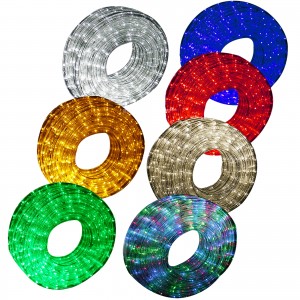
Now a day, LED lamps are used for both general and special-purpose lighting. Where colored light is needed, LEDs that inherently emit light of a single color require no energy-absorbing filters. White-light LED lamps have longer life expectancy and higher efficiency than most other lighting. LED sources are compact, which gives flexibility in designing lighting fixtures and good control over the distribution of light with small reflectors or lenses. Because of the small size of LEDs, control of the spatial distribution of illumination is extremely flexible, and the light output and spatial distribution of a LED array can be controlled with no efficiency loss. LEDs using the color-mixing principle can emit a wide range of colors by changing the proportions of light generated in each primary color. This allows full color mixing in lamps with LEDs of different colors. Unlike other lighting technologies, LED emission tends to be directional can be either advantageous or disadvantageous, depending on requirements. For applications where non-directional light is required, either a diffuser is used, or multiple individual LED emitters are used to emit in different directions.
A significant difference from other light sources is that the light is more directional, but LED lamps are used for both general and special-purpose lighting. Where colored light is needed, LEDs that inherently emit light of a single color require no energy-absorbing filters. White-light LED lamps have longer life expectancy and higher efficiency than most other lighting. LED sources are compact, which gives flexibility in designing lighting fixtures and good control over the distribution of light with small reflectors or lenses. Because of the small size of LEDs, control of the spatial distribution of illumination is extremely flexible, and the light output and spatial distribution of a LED array can be controlled with no efficiency loss. LED lamps are made that replace screw-in incandescent or compact fluorescent light bulbs, mostly replacing incandescent bulbs rated from 5 to 60 watts. As of 2010 some LED lamps replaced higher wattage bulbs. Some models of LED bulbs are compatible with dimmers as used for incandescent lamps. LED lamps often have directional light characteristics. LED lamps are available with a variety of color properties.
Several companies offer LED lamps for general lighting purposes. The technology is improving rapidly and new energy-efficient consumer LED lamps are available. LED tube lights are designed to physically fit in fixtures intended for fluorescent tubes. Some LED tube lamps are intended to be a drop-in replacement into existing fixtures. Others require rewiring of the fixtures to remove the ballast. An LED tube lamp generally uses many individual LEDs and may be directional. Fluorescent lamps emit light all the way around the lamp. Newer light fittings designed for LED lamps, or indeed with long-lived LEDs built-in, have been coming into use as the need for compatibility with existing fittings diminishes. Such lighting does not require each bulb to contain circuitry to operate from mains voltage.
LEDs have established their significance as a prominent replacement to conventional lighting, but with evolution of time and new innovations coming up, we can see LEDs crossed the lighting limit, and is coming across the edges of communication, Medical, industrial application areas. In this article, we are going to discuss, some of the innovative applications of LEDs coming up globally.
LEDs for Heads up display systems for Automobiles
The head-up display shows relevant information such as speed, navigation and infotainment data, as well as warnings in the driver’s direct field of vision. The head-up display’s virtual screen appears around two meters in front of the driver above the engine hood, so he is informed of all important issues without looking away from the road. The head-up display reduces driver distraction and increases driving safety.
A vibrant, full-color display makes new upcoming head-up display appeal to drivers. Compared with the previous, restricted color spectrum, new white LEDs project the entire color spectrum from the image generated on a TFT display. The increased brightness of the white LED technology in the new image generation unit means that the new head-up display offers significantly greater contrast and can also render features such as night view displays. LEDs, significantly reduce the power consumed (rated input) by the new head-up display. This efficiency makes the head-up display increasingly interesting for electric vehicles. Allowing the driver to configure the head-up display conveniently via the controls in the cockpit is a particular advantage in vehicles which are driven by several people. This is made possible by the use of a stepper motor that tilts the optical mirror inside the head-up display, in turn changing the position of the floating image displayed to the driver above the engine hood. Using the control elements in the cockpit the driver is able to comfortably adjust the head-up display to his seating position.
To enable the head-up display for use in mid-range vehicles, engineers are trying to develop two core requirements, Reducing size and weight and cutting manufacturing costs. The new layout of the optical components, which reflect the image from the display to the windscreen, has significantly lowered the number of overall components required. Combined with the intelligent use of modern materials, the developers were able to almost halve the volume and weight compared with the previous version.
LEDs are the best For Remote Visual Inspection
Remote visual inspection application is not the new one, but the concept keeps on innovating & most important part of a inspection system is its light source, The best light source depends on the application. Today, manufacturers can choose from halogen, xenon, metal halide and LED lighting to illuminate the area being remotely inspected. A halogen lamp is an incandescent lamp in that is affordable but produces yellowish light. A Xenon lamp is another type of lamp that produces a vivid white light with a high color temperature and volume but is large and heavy.
LED lighting is becoming more popular as the technology improves its ability to produce sufficient light. Benefits of LED lighting are to offer remote visual inspection users more portable videos-copes and bore-scopes that require less power consumption. Led light is very focused, less temperature dependent & very robust, making them 1st choice for the remote inspection system users. LEDs based inspection systems are now becoming 1st choice of users in consumer, automotive, and aerospace industries.
LEDs in UV LED Curing
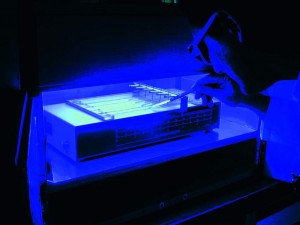
Curing with UV Light Emitting Diodes (UV LEDs) represents one of the singular biggest shifts occurring in printing and industrial drying, assembly and finishing technology today. Not only are the systems much more energy efficient, they contain no mercury, produce virtually no heat, are instantly activated On and Off, and can be produced in a much smaller footprint and with greater optical design freedom than any previous ARC lamp UV-Curing system. Perhaps the largest single benefit may be in the fact the UV photo polymerization process itself – long considered one of the most advanced and environmentally friendly finishing processes – is now accessible to a much wider base of adoption than ever before. UV LED curing technology is now delivering deep, consistent curing, top production speeds, heat-less operation and high reliability with unprecedented uptime to Flexographic tag and label producers. The introduction of market-ready UV LED curing inks from major manufacturers and an all-new ultra-high powered FLEXO Series edition of AMS award-winning XP5 LED UV curing platform are making this happen.
- Higher production speeds, especially with opaque whites and blacks
- Improved adhesion from 6x greater UV LED intensity
- No curing degradation over thousands of hours of production
- Downtime avoidance from air-cooled lamps over-temp or shutter faults
- No lengthy 15-minute warm-up cycle required at the start of each run
- No ozone generated into the pressroom
- No air recovery needed in the pressroom
- Approximately 50% energy reduction across the entire press
LED UV printing in the sheet-fed offset market has advanced rapidly and globally in the past several years – catching up with, and now even surpassing the performance of other forms of low energy (LE-type) and high wavelength or hybrid (H-type) UV curing. UV LED is now considered the fastest growing process technology for drying, protection and effects creation in the segment.
LEDs for Horticulture
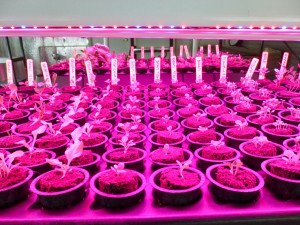
LED lighting is a development that also offers significant perspectives for greenhouse horticulture. In order to recognise the possibilities that this new technology opens up, scientist amassed extensive experience with LED lighting in test greenhouse. The system is named “The Hortiled system” was specially developed for the multi-layer cultivation of plant material in cultivation rooms. The advantages of this system are the unprecedented level of energy savings and lower heat generation. An additional benefit, when it comes to cultivation techniques, is that the color spectrum can be completely geared to suit the requirements of the crop. Thanks to the wide (150-degree) LED angle of radiation it is possible to create an optimum light distribution at a minimum distance from the crop. This enables growers to install more layers in a cultivation cabin and thus to use the space more efficiently.
LED inter-lighting fixture specially designed for tall greenhouse crops. An LED system placed between the plants enables more light to reach the plants in an optimal manner and ensures that light penetrates more deeply into the crop in order to stimulate growth there too. The major advantage here is that LED fixtures generate a lot less heat than SON-T lighting fixtures. The result is that more light reaches the plants directly without additional heat being produced in the greenhouse and without any burn damage being caused to plants. The color of the light can also be geared to suit the requirements of the plants. This research is done for, Young plants, Salad, Nursery, Seeds, Plants in a small space (without height), Tall greenhouse crops, Tomatoes, Peppers, Cucumbers
The advantages of LED lighting
- Virtually no radiation heat directed towards the crop. The additional heat generated by lighting often limits the duration of the lighting.
- Great light design freedom as the designer no longer has to take a single large light into account.
- It is possible to play with colors (responding to the plant requirements).
- Various light colors are suitable for use as control light as these give signals to the plants.
- LED light is extremely efficient (Umol per watt)
NASA and other researchers test LEDs for space crops
Healthy plants grown on a space station would purify water, regenerate oxygen, and provide fresh produce for the station’s astronauts. Some space crops might even produce bio-fuel that could – theoretically – serve as an alternative for fossil fuels. But cultivating plants at near zero-gravity and without the help of the sun is certainly next to impossible. A major challenge to growing plants in space will be controlling and supplying sufficient quantity and quality of light. Conventional lighting technologies would prohibit growing plants on a large scale in space due to low electric power conversion efficiencies. Conventional agricultural lighting solutions, which are sometimes called sun lamps or artificial-sunlight lamps, devour energy and give off far too much heat to be effective in space applications. And here comes the LEDs in picture.
LEDs are a promising electric light source even for space-based plant growth chambers and bio-regenerative advanced life support because of their small mass and volume, solid state construction, safety, and longevity. In addition to being energy efficient and relatively cool, LEDs can provide plants with the proper quality of light, too. Earlier NASA experiments with salad-type plants also used red and blue LEDs in combination to generate relatively good results. Specifically, the LED arrays in the NASA tests included red LEDs with peak wavelengths of 664, 666, 676, and 688 nanometers (nm) along with a row or rows of blue LEDs emitting a wavelength of 474 nm. Interestingly, a study from the Universal Society for Horticultural Science also used LEDs with peak wavelengths from 460-688 nm when it researched the potential for narrow band lighting in earthbound greenhouses. Green LEDs, which are mentioned in more detail below, help make space plants appear more edible and green.
LED lighting for space-grown strawberries
LED testing is the next step for the Seascape variety of strawberry. The Seascape strawberry requires 10 hours per day or less of light and meets NASA’s mass and waste requirements since the berries are small relative to other fruit and almost entirely consumable. The Seascape variety also tends to grow fewer, larger berries, which is important in space cultivation since there are no insects or gentle breezes to spread pollen. Rather, astronauts will have to manually pollinate the plants like the Seascape, so fewer individual berries are actually better as long as the yield remains the same.
LEDs in dentistry
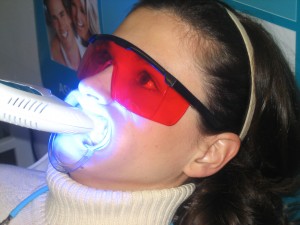
These days’ innovative instruments are available to the dentist which helps to ensure effective treatments that are also gentle on the tooth enamel. The new LED generator technology allows for an independent, detailed illumination of the treatment area with fantastic light quality. This enables the dentist to see structures even in posterior jaw regions which are difficult to access and can help the dentist work precisely.
A dental curing light is a piece of dental equipment that is used for polymerization of light cure resin based composites. The light used falls under the visible blue light spectrum. This light is delivered over a range of wavelengths and varies for each type of device. The latest LED curing light is the high powered LED light. This newest light is an updated LED curing light and can cure material much faster than the Halogen and the previous LED curing lights. It uses a single high-intensity blue LED that uses a larger semi conductor crystal. This increased the light intensity and the area that is illuminated with an output of 1,000 mW/cm2. The dental LED curing lights use LED’s that produce a narrow spectrum of blue light in the 400- to 500-nm range (with a peak wavelength of about 460nm), which is the useful energy range for activating the CPQ molecule most commonly used to initiate the photo-polymerization of dental monomers. The heat generated from LED curing lights is much less which means it does not require a fan to cool it. Now that the fan is not needed, a more lightweight and smaller light could be designed. The portability of it comes from the low consumption of power. The LED can now use rechargeable batteries, making it much more comfortable and easier to use.
LEDs for Photo-Dynamic Therapy
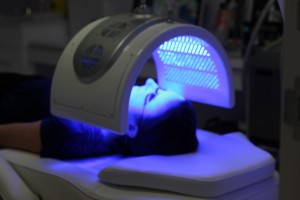
Photodynamic therapy (PDT) with a LED system is a non-invasive, highly effective treatment option for actinic keratosis and other pre-cancers as well as basal cell carcinomas. PDT selectively destroys epidermal and dermal tumor cells and even treats large areas safely with excellent clinical and aesthetic results.
Photodynamic Therapy (PDT) is a cancer treatment which uses a photosensitive drug along with light to destroy and kill cancer. There are many variables for this treatment including the type of drug, light spectrum, and light sensitivity issues afterwards. Over the last couple of years, manufacturers have worked hard at making LED’s more user friendly as well as much smaller and more powerful. There are many uses in which LED’s can replace the more commonly used incandescent light sources. several applications are available now to push LED’s to output levels not imagined before now.
LED’s are able to distribute an even light output over areas that require wide angle light output. For narrow or more focused angles, there are LED’s on the market that provide some focusing. When really narrow focus is required there is special optics now available to provide the same level of focusing as lasers. This becomes a major benefit as LED’s are about 1/3 the cost of some lasers. The first light was designed with a rounded head of LED lights which is available in several different sizes depending on the patient’s requirements and area of treatment. Researchers have LED’s available from several different spectrums in order to activate each different drug being used in the treatment. This particular style of light was designed with the intent of treating soft cell sarcomas, as well as skin cancers. This second light has been designed for use in photodynamic therapy treating internal cancerous tissue/tumors.
LED-to-LED Visible Light Communication
The LED-to-LED communication enables new mobile applications for entertaining and creative use cases and provides a low-cost, low-complexity path to light communication. Visible light is already often part of our environments, so VLC provides a unique opportunity to provide communication capabilities that is not noticed. Visible Light Communication (VLC) is a creative approach for novel mobile applications. Games, toys, location services, and augmented reality are example applications that can benefit from using visible light for communication. VLC is a relatively new approach for optical free space mobile networks. It has been so far mainly considered for Internet access or home networks, but more creative use cases are possible. The LED-to-LED communication and the contention-based medium access protocol with collision detection enable new mobile applications for entertaining and creative use cases. Compared to radio solutions like WLAN or cellular, the potential benefits of VLC are the unrestricted use of devices (the optical spectrum is unlicensed), the visibility of the connections (which can be part of the creative experience), and the fact that light sources are already all around us.
Light communication has several advantages: Light communication is visible (in contrast to invisible radio communication), so it is easy to determine who can listen to (or receive) a message. Furthermore, light communication does not use radio waves, and there are environments or communities that may value this aspect. A side effect is that light communication does not require part of the (limited) radio spectrum and can therefore be seen as a suitable extension in bandwidth-limited scenarios. And (visible) light is present in many places, so there is the opportunity to combine light communication with lighting design to let Visible Light Communication (VLC) coexist with (or even benefit from) the lighting setup present in many offices, homes, or institutions. The VLC principle is a relatively new approach for optical free space applications. However, it has been so far considered mainly for Internet access or home networks, but more creative use cases are feasible. For example, VLC can be employed for toy cars or may allow a magic wand to control light effects on a dress LEDs provide an almost ideal platform for VLC. An LED
can emit and receive light at the same time (with multiplexing). In the present paper we present an LED-to-LED communication system for Visible Light Communication (VLC). Such a system can modulate light intensity with high frequencies so that the human eye is not affected by the light communication; the eye always perceives a continuous light even though optical messages are transmitted. The system has a low complexity and uses LEDs to achieve
bidirectional communication avoiding the use of photo-detectors.
Bidirectional communication is obtained by temporal separation of transmitter and receiver signals. To achieve bidirectional communication using a slotted carrier sense multiple access (CSMA), devices must be synchronous. In this paper, we describe a synchronization model where the receiver is able to lock to the transmitted signal in a fast and efficient way. The system has been realized in a testbed that allows us to gain novel insights. The system uses single LEDs for transmission and reception using an On-Off Keying modulation; the result is a low-power system for low data rate applications.
LED based Internet Communication, Li-Fi
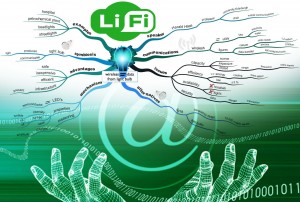
Here’s a bright idea: instead of radio waves, use light to get online. Unlike wi-fi, or wireless fidelity, so-called Li-Wi, transmits data through variations in light intensity. Li-Fi, or light fidelity, refers to 5G visible light communication systems using light from light-emitting diodes as a medium to deliver networked, mobile, high-speed communication in a similar manner as Wi-Fi. Li-Fi can be used to off-load data from existing Wi-Fi networks to provide capacity for the greater downlink demand as complementary to the existing wireless or wired network infrastructure. Li-Fi could lead to everything electronic being connected to the internet with the lights on the electronics being used as internet access points. The Li-Fi market is projected to be worth over $6 billion per year by 2018. The technology works only when the LED’s light can reach the gadget. Stray from the LED, and you lose your connection. On the plus side, the visible light spectrum can handle way more traffic than Wi-Fi’s already crowded radio spectrum. And any LED bulb can be a network connection. We may someday look back at Wi-Fi as technology from the dark ages.
Visible light communications (VLC) signals work by switching bulbs on and off incredibly quickly – too quickly to be noticed by the human eye. Although Li-Fi bulbs would have to be kept on to transmit data, the bulbs could be dimmed to the point that they were not visible to humans and yet still functional. The light waves cannot penetrate walls which makes a much shorter range, though more secure from hacking, relative to Wi-Fi. Direct line of sight isn’t necessary for Li-Fi to transmit signal and light reflected off of the walls achieve 70 Mbps.
Li-Fi has the advantage of being able to be used in electromagnetic sensitive areas such as in aircraft cabins, hospitals and nuclear power plants without causing electromagnetic interference. Both Wi-Fi and Li-Fi transmit data over the electromagnetic spectrum, but whereas Wi-Fi utilizes radio waves, Li-Fi uses visible light. The US Federal Communications Commission has warned of a potential spectrum crisis because Wi-Fi is close to full capacity, Li-Fi has almost no limitations on capacity. The visible light spectrum is 10,000 times larger than the entire radio frequency spectrum. Researchers have reached data rates of over 10 Gbps, which is more than 250 times faster than superfast broadband. Li-Fi is expected to be ten times cheaper than Wi-Fi, to be highlighted.






